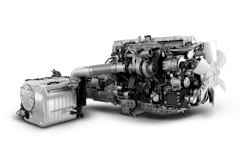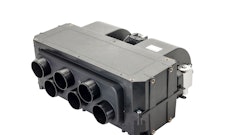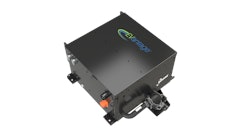
With approximately 2.5 million electric vehicles (EVs) on U.S. roads and U.S. sales doubling from 2020 to 2021, EVs have evolved past being only a purchase for highly eco-conscious early adopters. A similar dynamic can be seen off-highway, which is expected to experience a substantial 21.5% compound annual growth rate between 2021 and 2030. With EVs quickly transitioning from the vehicle of the future to the vehicle for today, new trends are emerging to support manufacturer and regulatory goals of making EVs increasingly acceptable, accessible and attractive for a growing number of individuals and industries. High on the list is thermal management, specifically improving cabin comfort without contributing to “range anxiety.” At the heart of this solution, we find R-1234yf—the zero ozone depletion potential (ODP), low global warming potential (GWP) refrigerant that’s dominating the EV space as the preferred refrigerant for heat pumps.
Initial EV Heating Technology
To prove the concept that heating and cooling could work successfully in all-electric plug-in and hybrid vehicles, engineers equipped the first EVs with electric resistive heaters using a positive temperature coefficient (PTC) heating element. This approach did what needed to be done, plus building the system into the vehicle was convenient, parts were available and the overall complexity level was low. However, electric resistive heaters create heat from battery energy, negatively impacting vehicle range. Moreover, the colder the ambient air, the more energy the heating system requires to maintain a comfortable cabin temperature. Lastly, the harder a battery works, the less durable it becomes. So, as “range anxiety” crept into the psyche of EV operators, electric resistive heaters were on the hot seat.
The concerns with these heaters are valid. According to AAA, driving and using an EV’s heater at or below 20°F can decrease the average range by 41%. In off-highway EVs, challenges of electric resistive heating become steeper, because the battery is tasked with fueling bigger systems, and in many off-road applications, recharging options are limited. A few years ago, this publication partnered in gathering viewpoints from OEMs about the future of off-road EVs, which revealed battery power as the biggest challenge to going electric. Reserving every potential unit of energy generated by the battery for the purpose of vehicle range and operation capacity became the focus of new HVAC technology for light, medium, and heavy-duty EVs.
Advantages of Heat Pumps for EVs
In 2012, the Nissan Leaf became the first mass-produced EV to offer heat pump thermal management, providing the industry with the more energy-efficient system it demanded. The option quickly gained favor, especially among European manufacturers like Jaguar, BMW and Volkswagen. Today, more and more EVs are factory-designed with heat pumps. Unlike electric resistive heaters, heat pumps do not generate heat. Instead, they move heat from one place to another—either absorbing heat from ambient air and transferring it into the cabin for warmth or removing heat from the cabin to cool it. Heat pumps are highly attractive for EVs because they utilize an endless reserve of “free” source energy from outside air, instead of using battery energy. They generate up to three units of heat for every one unit of energy consumed—compared with a PTC’s one-to-one output. In addition, heat pumps work “both ways” to heat and cool, and may help extend a battery’s durability by putting less work on the battery.
Why R-1234yf Is the Best Commercial Solution
With all indications pointing to heat pumps as the right answer for many of the challenges of previous cabin comfort systems—especially in the range anxiety category—scientists and engineers next turned to honing heat pump technology. This put the focus on the refrigerant, which plays a critical role in a heat pump’s effectiveness. Today, R-1234yf—the same refrigerant quickly overtaking automotive manufacturing and aftermarket as the refrigerant of choice for air conditioning systems in other types of vehicles—is dominating the EV space as the preferred refrigerant for heat pumps. Advantages R-1234yf offers EV heat pump applications include:
- Low boiling point, which makes it ideal for cold-weather performance
- High critical temperature, which makes it effective in hot ambient temperatures as well
- System cooling performance similar to R-134a
- Environmental impact of ODP and low (less than 1) GWP
- Commercial availability and supply resilience, an advantage over the legacy refrigerant R-134a, which is being regulated by regional, national, and global sustainability policies
R-1234yf Versus Carbon Dioxide
Carbon dioxide (CO2) remains a popular refrigerant choice for EV heat pumps, but it has several challenges that R-1234yf addresses. Because CO2 has a low critical temperature, it needs to operate at high pressures, requiring a unique compressor, special components, and a great deal of metal around a small channel to contain that pressure. All these translate into a heavier system, and weight costs an EV in driving range. In addition, CO2 requires more complex maintenance and the hazard of operating a vehicle containing a refrigerant under high pressure. Moreover, R-1234yf covers more of the cabin comfort temperature range than CO2, which operates poorly at temperatures above approximately 32°F. Chemists and refrigerant innovators appreciate CO2’s environmental advantages (it sets the baseline of the GWP scale), but its technical and safety challenges coupled with poor high-ambient performance make it less desirable than R-1234yf for system designers.
The Road Ahead for Off-Highway EV Thermal Management
The heat pump solution is here to stay for EV cabin comfort. And for the reasons above, R-1234yf offers the best solution for heat pump thermal management. However, best is not perfect. The industry is very close to introducing refrigerant blends that use R-1234yf as the ideal base. These optimized blends will augment R-1234yf with other materials to further improve performance and efficiency and potentially allow for heat pump systems with fewer components and lighter weights. Scientists are also in the lab to innovate formulations that could take refrigerant GWPs even lower.
As EVs continue to approach cost, range, comfort, power, “refueling” option, and availability parity with gas-powered vehicles, you’ll see more people make the switch to EVs. And as more of these vehicles appear on and off the highway, governments will keep a close eye on the environmental impact of refrigerants. The same regulatory landscape—namely the European transition away from R-134a use in all light-duty vehicles and similar regulations currently in the works from the U.S. EPA—that has resulted in 80 million R-1234yf-charged vehicles being driven on U.S. roads and nearly 30 manufacturers adopting it for gas-powered vehicles, is coming into play for EVs. We can expect to see an exponential increase in heat pumps that utilize zero-ODP, low-GWP R-1234yf and R-1234yf blends to support sustainability initiatives and better overall energy efficiency.



















